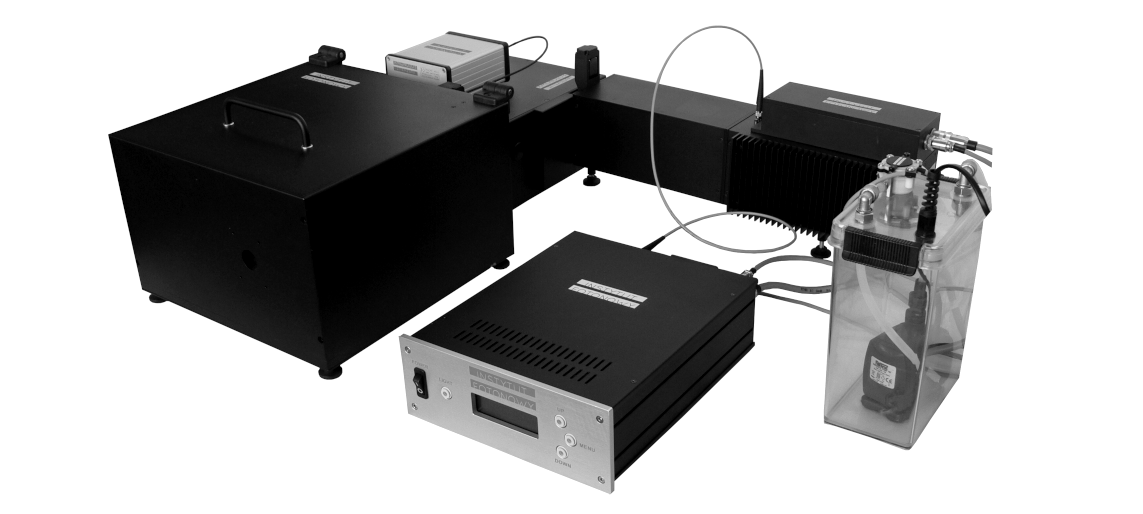Photoelectric Spectrometer for quantum efficiency measurements
Couldn't load pickup availability
Delivery and Shipping to EU
Delivery and Shipping to EU
We will add in the quotation, the shipping, insurance, customs clearance costs.
Photoelectric Spectrometer for quantum efficiency measurements
Instytut Fotonowy
Description
Photoelectric Spectrometer serves as a scientific tool to automatically characterize photoelectric properties of samples illuminated with relatively strong UV, VIS and NIR light as a function of incident wavelength. Advanced software allows to record photocurrent action maps, photovoltage action maps along with potentiodynamic and galvanodynamic measurements at constant wavelength, both in CW and pulsed mode. Incident Photon to Converted Electron (IPCE) and, if Integrating Sphere available, Absorbed Photon to Converted Electron (APCE) ratio may be evaluated as a function of wavelength and bias potential. The emitted light wavelength, intensity and edge filters handling are controlled via software. The Monochromator is equipped with up to four switchable gratings to uniformly cover wide range of wavelengths. The Air Mass Filter may be applied at the Xenon Lamp output to mimic the solar radiation. The instrument is ready to be coupled with the Kelvin Probe and other devices.
Quantities measured by the instrument:
Electric current of the sample (chronoamperometry, CA),
Open Circuit Potential (OCP) as a function of light wavelength,
Photocurrent of the sample illuminated with white or monochromatic light,
I-V characteristics,
Light transmittance of the sample (with the Light Calibrator),
Light intensity reaching the sample (with the Light Calibrator),
Action maps (photocurrent as a function of potential and wavelength),
IPCE maps as a function of potential and wavelength,
APCE maps as a function of potential and wavelength (with the Integrating Sphere),
Sample reflectance (with the Integrating Sphere).
Spectrometer module system
Sample Chamber,
Monochromator for UV, VIS and IR light,
Potentiostat for full characterisation of electric properties,
Xenon Lamp with the controller and water cooling system,
Electrochemical Cuvette with Pt working electrode (WE) and Ag/AgCl reference electrode (RE),
FotoGUI software.

Inside the Sample Chamber


Specifications
Instrument performance may be tailored to the certain requirements..
Xenon Lamp
150 W xenon burner,
Water cooling system,
Low EM emission igniter,
Stabilization modes:
– electric current stabilization (distortions < 1%),
– electric power stabilization,
– light intensity stabilization (unique solution to provide constant sample illumination during the experiment),
Maximum radiation intensity on the sample: 35 mW/cm2
Filter Wheel
Up to six filters on the carousel,
Two edge (long pass) filters provided by default: 400 nm and 510 nm,
Monochromator
Spectral range: 200 ÷ 1200 nm (gratings dependent),
Up to four gratings on the turret,
Automated switching of the turret position, operated via software,
Motorized slits, controlled via software,
Entrance and output slit opening range: 0 ÷ 5 mm,
Motorized internal shutter that provides full cut off of the light beam, controlled via software,
Maximum spectral resolution: 0.1 nm (depends on the input and output slits width),
Potentiostat
Bias potential range: -5 V ÷ 5 V,
Current ranges: 10 nA, 100 nA, 1 µA, 10 µA, 100 µA, 1 mA, 10 mA,
Current resolution: from 1 pA to 100 nA (range dependent),
Controller
Maximum sampling rate: 1 kSample/s,
Connection with PC: via USB 2.0,
Two photodiode inputs that may be simultaneously handled,
RS485 socket to control devices,
Typical light intensity output of the Photoelectric Spectrometer
The light intensity produced on the sample depends on the wavelength and width of the input and output slits. In the picture, a typical light intensity from the Xenon Lamp and two 1200 gr/mm gratings: optimized for 300 nm and for 500 nm installed in the Monochromator.




